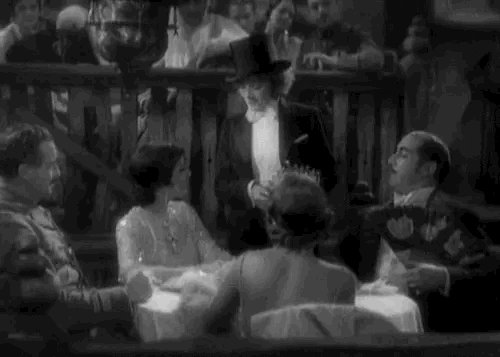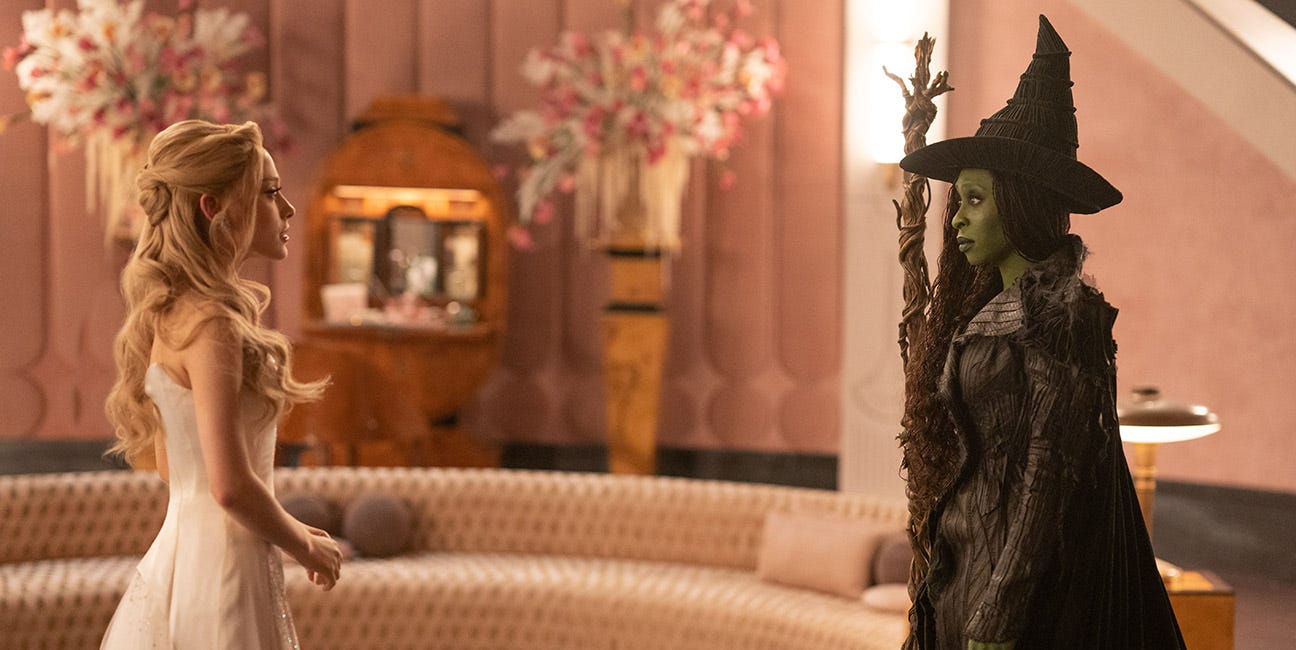What’s In A Kiss?
On-screen smooching has always been gay
This is the Sunday Edition of Paging Dr. Lesbian. If you like it, subscribe, and share it with your friends. Upgrade your subscription for more, including weekly dispatches from the lesbian internet, monthly playlists, and a free sticker. I’m a full-time freelance journalist – your support goes a long way!
What would cinema be without kissing? One of the most evocative images in all of film, the on-screen kiss has animated the medium since its inception. That cinematic kissing was limited to heterosexual couples in the first several decades of the film industry seems like a given, but that’s not entirely true. In fact, the first smooch ever captured on film was a kiss between two women.
An early film pioneer, Eadweard Muybridge began experimenting with photography in motion in the late 1870s, most notably with his The Horse in Motion series. In 1882, he created The Kiss, a series of stitched-together images depicting two naked women kissing. Thomas Edison was previously credited with introducing the kiss to this new medium with his film of the same name in 1896, but Muybridge and his women beat him by over a decade.
Though we can’t say for sure how the image was conceived and perceived during this period, it’s more than likely that Muybridge’s short film wasn’t seen in a sexual light, despite the nudity. Muybridge was fascinated with science, anatomy, and the movement of bodies, and most assume The Kiss was an extension of those curiosities. Moreover, during the Victorian Era, which also coincided with the rise of sexology, it was commonly thought that women had little or no sex drive. For that reason, among others, the notion of women experiencing lesbian sexual attraction was almost unthinkable.
Indeed, many of cinema’s earliest depictions of queer sexuality and romance slipped by implicit censorship because the average moviegoer refused to see queerness as a possibility. In 1927, Paramount released Wings, a pioneering aviation action film and the first movie to win Best Picture at the Oscars. Alongside that accolade, Wings is often credited as featuring the first gay kiss in movie history.
The story follows two men, Jack (Charles “Buddy” Rogers) and David (Richard Arlen). They become entangled in a love triangle with Mary (Clara Bow, Hollywood’s biggest star of the era). When they join the war effort as combat pilots, Jack and David forge a close friendship and mostly forget about Mary. In a climactic moment in the film, the men share a kiss as one of them lies dying in the other’s arms. “You know there is nothing in the world that means so much to me as your friendship,” Jack proclaims. “I knew it – all the time,” David responds
.While the gay subtext – which is essentially text – might have gone over the heads of straight audiences at the time, the queer resonance jumps out today. Mary does return at the end to remind us that straight love is what matters, but that doesn’t erase this earlier declaration of love. The kiss didn’t generate any controversy, perhaps because the friendly nature of the kiss could be easily (though not believably) argued. Either way, filmmakers could be more freewheeling when it came to sexuality during the Pre-Code era, as there weren’t any rules prohibiting queerness. Who knows if the gay kiss would be included if the film were released a decade later?
Though the kiss in Wings is often cited as a Hollywood first, that doesn’t tell the full story. Betty Compson and Olga Baclanova locked lips in the 1928 film The Docks of New York. In 1925, a whole group of women took turns kissing each other in Lady of the Night. Though these kisses were almost certainly framed within the context of friendship, their presence in film history muddies the simple dichotomy between queer presence and absence in early Hollywood productions.
Without a doubt, the most famous lesbian kiss of this era occurs in the 1930 Josef von Sternberg movie Morocco. Sternberg’s muse, Marlene Dietrich, plays Amy, a nightclub singer working at an establishment in the titular city. The iconic kiss transpires during Amy’s act. Dressed in a perfectly tailored tuxedo and top hat, Amy saunters over to a woman in the audience and kisses her right on the lips. Though it takes place within the context of her performance, Amy’s sensual maneuver is clearly a seduction.
The Morocco kiss becomes more interesting when you consider Dietrich’s star persona. As openly queer as one could be at the time, Dietrich’s frequent escapades with celebrities of both genders were legendary. Dietrich pushed the boundaries of acceptability outside of her films. She created a scandal when she wore a tuxedo to the 1932 premiere of Cecil B. DeMille’s The Sign of the Cross, refusing to play by the era’s fashion rules. But that wasn’t the first time she wore a suit to a film premiere. In fact, just one month prior, Dietrich wore a tux to the American premiere of a German film called Mädchen in Uniform.
Often described as the first lesbian film, Mädchen in Uniform contains another historic kiss. The film takes place at a boarding school, where many of the young women are obsessed with one of their teachers. The protagonist takes her love a step further and steals a kiss from the revered teacher during their rather libidinous nighttime routine. Released in Germany in 1931, the film emerged during the final years of the freewheeling Weimar Republic, from which Dietrich also hailed.
Another famous lesbian kiss appeared in the 1933 film Queen Christina, starring Greta Garbo, Dietrich’s mysterious off-screen rival. While playing the historical queen, Garbo mostly dresses in men’s clothing. In one memorable scene, she kisses a duchess squarely on the lips. Though the film’s text contextualizes the kiss as friendly, Garbo’s passion in the scene tells a different story. Released the year before the Production Code was regularly enforced, Queen Christina exemplifies the instructive gap between what’s on the surface and what lies beneath.
Kissing of all types was seen as a taboo subject at the turn of the century, when the nascent film industry began to expand. The Roman Catholic Church – the same entity responsible for the conservative Production Code – called Edison’s The Kiss “shocking,” while a critic described it as “absolutely disgusting.” Kisses have historically carried a lot of weight within the film industry. As A.O. Scott writes, “A movie kiss was also, for a long time and under various formal and informal censorship regimes, a substitute for everything else,” including, of course, sex. Still, despite its fraught place in the industry, Scott argues that “movies helped make [kissing] more essential.”
These early examples of gay kissing complicate assumptions about sexuality, love, and intimacy during Hollywood’s first few decades. Many of these kisses were framed as platonic, yet the intimacy of these displays of affection can’t be denied. Even if these smooches were performed and conceived of as friendly acts, it’s also true that the social impossibility of lesbianism meant some queer women were able to hide in plain sight. For example, while not all of the women involved in Boston marriages, a socially permissible cohabitation between two women, harbored romantic feelings for each other, this arrangement most definitely allowed some lesbian couples to build their lives together without suspicion.
This kissing history supports the argument that queerness has been part of the fabric of Hollywood since its inception, even if it wasn’t recognized as such. As Scott argues, kissing once represented the entire spectrum of platonic and sexual intimacy, and to ignore the presence of queerness within this representational act would deny cinema’s greatest magic trick: the ambiguous nature of cinematic meaning, composed of that elusive mixture of creative intention and personal/political history.
damn, these witches gay!
Welcome to this week’s dispatch from the lesbian internet, a mid-week news roundup from Paging Dr. Lesbian, exclusively for paid subscribers.









Loved this! Beautifully written, thank you for this wonderful look into the history of queer kisses in cinema. Gosh, so much of queer resonance in film has been in the relating to the "subtext", it hurts me to think of all of us looking "between the lines" to see ourselves, and how straight people don't even recognize it. I am glad to see non-ambiguous queer representation in film today. Yet, still I want to see more, like showing us in our full humanity, joyful not always tragic (as a lesbian filmmaker myself, I am on it!!!!). Thank you, Kira!
This was fascinating- I LOVED this! I still have so much to learn and just recently started getting into black and white movies so I’m going to find a way to watch Morocco.